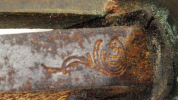- Joined
- Jun 9, 2018
- Messages
- 34
This sat for ages, and I had initially dismissed this blade as fraternal or ceremonial, perhaps even a theatrical prop.
It looked weird, right from the get-go.
Now, having examined it closer, the use of gilt or gold wash, the blade etchings or engravings, the well-fitted, leather covered scabbard, and various other aspects suggest it's more than I thought.
Put together on flickr.com a 23-photo album of shots. Best way to view is to sign in with any old Yahoo i.d. and one can then view captions, enlarge, navigate, and do searches.
My collection alone is some 8200+ images.
I am going to try to re-do the links, or use the graphics set up in here.
Oddly, they worked in all the other venues where I posted them.
Maybe the "album" link will suffice.
https://www.flickr.com/photos/15631192@N04/albums/

The "blade folks" I've shown the sword or images suggest it might be from at least a half dozen different countries, and it's been called a "sort of scimitar" and a "kilij".
Me? I come up empty.
The symbolism of the seemingly "peace related" images on the blade struck me as particularly unusual.
I am brand new here, so if this is in a wrong place or weirdly inappropriate, please advise or move or whatever's necessary.
A friend told me it might be a high-ranking Polish Officer's Model of 1934 presentation blade.
Just a puzzle.
There is no maker's mark I can find, unless it's somehow encoded in the symbology.
The fitting on the guard and leather wrap is very well done, and that unusual second "saddle ring" suggests it was setup to hang on tack gear.
There are finials on that appliance and I think they may be adapted uniform buttons.
I'm trying to track that down right now.
Thanks.
Happy to be here.
It looked weird, right from the get-go.
Now, having examined it closer, the use of gilt or gold wash, the blade etchings or engravings, the well-fitted, leather covered scabbard, and various other aspects suggest it's more than I thought.
Put together on flickr.com a 23-photo album of shots. Best way to view is to sign in with any old Yahoo i.d. and one can then view captions, enlarge, navigate, and do searches.
My collection alone is some 8200+ images.
I am going to try to re-do the links, or use the graphics set up in here.
Oddly, they worked in all the other venues where I posted them.
Maybe the "album" link will suffice.
https://www.flickr.com/photos/15631192@N04/albums/

The "blade folks" I've shown the sword or images suggest it might be from at least a half dozen different countries, and it's been called a "sort of scimitar" and a "kilij".
Me? I come up empty.
The symbolism of the seemingly "peace related" images on the blade struck me as particularly unusual.
I am brand new here, so if this is in a wrong place or weirdly inappropriate, please advise or move or whatever's necessary.
A friend told me it might be a high-ranking Polish Officer's Model of 1934 presentation blade.
Just a puzzle.
There is no maker's mark I can find, unless it's somehow encoded in the symbology.
The fitting on the guard and leather wrap is very well done, and that unusual second "saddle ring" suggests it was setup to hang on tack gear.
There are finials on that appliance and I think they may be adapted uniform buttons.
I'm trying to track that down right now.
Thanks.
Happy to be here.
Last edited:

